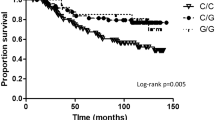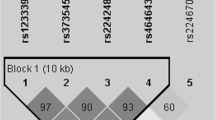Abstract
The cytochrome P450 family (CYPs) and the glutathione S-transferase (GSTs) enzymes play an important role in the metabolism of environmental carcinogens and of oestrogen and can affect breast cancer risk. In this study we examine the role of the genes CYP1A1, CYP17, CYP2D6, GSTM1, GSTP1 and GSTT1 in breast cancer risk in Brazilian women. The study population consisted of 102 incident breast cancer cases and 102 healthy controls. Genotyping analyses were performed by PCR-based methods. A significant finding was observed between GSTP1 Ile-Val polymorphism and breast cancer risk (OR = 1.81; CI 95% = 1.04–3.16). A significant association was observed between women with 0–2 risk genotypes and those with 4 or more risk genotypes (OR = 2.42; CI 95% = 1.13–5.18) when the potential combined effects of the risk genotypes were examined. No significant differences between cases and controls were found correlating the genotypes and the clinical-histopathological parameters. In conclusion, in our population only GSTP1 was associated with breast cancer risk. However, when the genes were tested in combination, a significant association in the breast cancer risk was observed.
Similar content being viewed by others
References
INCA/MS, Instituto Nacional de Câncer do Ministério da Saúde (2007) http://www.inca.org.br. Accessed July 2007
Yager JD (2000) Endogenous estrogens as carcinogens through metabolic activation. J Nat Cancer Inst Monographs 27:67–73
Nebert DW, Mckinnon RA, Puga A (1996) Human-drug metabolizing enzyme polymorphisms: effects on risk of toxicity and cancer. DNA Cell Biol 15:273–280
Han W, Kang D, Park, IA et al (2004) Associations between breast cancer susceptibility gene polymorphisms and clinicopathological features. Clin Cancer Res 10:124–130
Kawajiri K, Nakach IK, Imai K et al (1990) Identification of genetically high risk individuals to lung cancer by DNA polymorphisms of the cytochrome P-450IA1 gene. FEBS Lett 263:131–133
Taioli E, Trachman J, Chen X et al (1995) A CYP1A1 restriction fragment length polymorphism is associated with breast cancer in African-American women. Cancer Res 55:3757–3758
Taioli E, Bradlow HL, Garbers SV et al (1999) Role of estradiol metabolism and CYP1A1 polymorphisms in breast cancer risk. Cancer Detect Prev 23:232–237
Garte S, Gaspari L, Alexandrie AK et al (2001) Metabolic gene polymorphism frequencies in control populations. Cancer Epidemiol Biomarkers Prev 10:1239–1248
Crocitto LE, Feigelson HS, Yu MC et al (1997) A polymorphism in intron 6 of the CYP17 gene. Clin Genet 52:68–69
Carey AH, Waterworth D, Patel K et al (1994) Polycystic ovaries and premature male pattern baldness are associated with one allele of the steroid metabolism gene CYP17. Human Mol Genet 3:1873–1876
Kristensen VN, Haraldsen EK, Anderson KB et al (1999) CYP17 and breast cancer risk: the polymorphism in the 5 flanking area of the gene does not influence binding to Sp-1. Cancer Res 59:2825–2828
Hong CC, Thompson HJ, Jiang C et al (2004) Association between the T27C polymorphism in the cytochrome P450c17α gene (CYP17) and risk factors for breast cancer. Breast Cancer Res Treatment 88:217–230
Ambrosone CB, Moysich KB, Furberg H et al (2003) CYP17 genetic polymorphism, breast cancer and breast cancer risk factors. Breast Cancer Res 5:45–51
Stuven T, Griese EU, Kroemer HK et al (1996) Rapid detection of CYP2D6 null alleles by long distance-and multiplex-polymerase chain reaction. Pharmacogenetics 6:417–421
Ladona MG, Abildúa RE, Ladero JM et al (1996) CYP2D6 genotypes in Spanish women with breast cancer. Cancer Letters 99:23–28
Osborne CK (1998) Tamoxifen in the treatment of breast cancer. N Engl J Med 339:1609–1618
Egan KM, Cai Q, Shu X et al (2004) Genetic polymorphisms in GSTM1, GSTP1, and GSTT1 and the risk for breast cancer: results from the Shanghai breast cancer study and meta-analysis. Cancer Epidemiol Biomark Prev 13:197–204
Millikan R, Pittman G, Tse C et al (2000) Glutathione S-transferases M1, T1, and P1 and breast cancer. Cancer Epidemiol Biomark Prev 9:567–573
Parl FF (2005) Glutathione S-transferase genotypes and cancer risk. Cancer Lett 221:123–129
Forrester LM, Hayes JD, Millis R et al (1990) Expression of glutathione S-transferases and cytochrome P450 in normal and tumor breast tissue. Carcinogenesis 11:2163–2170
Board PG, Coggan M, Johnston et al (1990) Genetic heterogeneity of the human glutathione transferases: a complex of gene families. Pharmacol Therap 48:357–369
Mitrunen K, Jourenkova N, Kataja V et al (2001) Glutathione S-transferase M1, M3, P1, and T1 genetic polymorphisms and susceptibility to breast cancer. Cancer Epidemiol Biomark Prev 10:229–236
Miller SA, Dykes DD, Polesky HF (1988) A simple salting out procedure for extraction DNA from human nucleated cell. Nucleic Acid Res 16:1215
Carstensen U, Alexandrie AK, Högstedt B et al (1993) B-and T-lymphocyte micronulei in chimney sweeps with respect to genetic polymorphism for CYP1A1 and GST1 (class Mu). Mut Res 289:187–195
McKean-Cowdin R, Feigelson HS, Pike MC et al (2001) Risk of endometrial cancer and estrogen replacement therapy history by CYP17 genotype. Cancer Res 61:848–849
Sobit RC, Al-Badran AI, Sharma SK et al (2005) Genetics polymorphisms of CYP2D6, GSTM1, and GSTT1 genes and bladder cancer risk in North India. Cancer Genet Cytogenet 156:68–73
Abdel-Rahman SZ, El-Zein RA, Anwar WA et al (1996) A multiplex PCR procedure for polymorphic analysis of GSTM1 and GSTT1 genes in population studies. Cancer Lett 107:229–233
Harries LW, Stubbins MJ, Forman D et al (1997) Identification of genetic polymorphisms at glutathione S-transferases Pi locus and association with susceptibility to bladder, testicular and prostate cancer. Carcinogenesis 18:641–644
Miller MP (1997) RXC: a program for the analysis of contingency tables. Department of Biological Sciences, Northern Arizona University. Free program distributed by the authors over the internet from the RxC Home Page at http://herb.bio.nau.edu/miller/rxc.htm
Park SK, Kang D, Noh DY et al (2003) Reproductive factors, glutathione S-transferase M1 and T1 genetic polymorphism and breast cancer risk. Breast Cancer Res Treat 78:89–96
Collins JA, Blake JM, Crosignani PG (2005) Breast cancer risk with postmenopausal hormonal treatment. Human Reprod Update 11:545–560
Van Der Hel OL, Bueno-De-Mesquita HB, Van Gils CH et al (2005) Cumulative genetic defects in carcinogen metabolism may increase breast cancer risk. Cancer Causes Control 16:675–681
Amorim LMF, Rossini A, Mendonça G et al (2002) CYP1A1, GSTM1 ad GSTT1 polymorphisms and breast cancer risk in Brazilian woman. Cancer Lett 181:179–186.
Huang CS, Shen CY, Chang KJ et al (1999) Cytochrome P4501A1 polymorphism as a susceptibility factor for breast cancer in postmenopausal Chinese women in Taiwan. Br J Cancer 80:1838–1843
Bergman-Jungestrom M, Gentile M, Lundin AC and the SouthEast Breast Cancer Group (1999) Association between CYP17 gene polymorphism and risk of breast cancer in young women. Int J Cancer 84:350–353
Charrier J, Maugard CM, Le Mevel B, Bignon YJ (1999) Allelotype influence at glutathione S-transferase M1 locus on breast cancer susceptibility. Br J Cancer 79:346–353
Park SK, Yoo KY, Lee SJ et al (2000) Alcohol consumption, glutathione S-transferase M1 and T1 genetic polymorphisms and breast cancer risk. Pharmacogenetics 10:301–309
Roodi N, Dupont WD, Moore JH, Parl FF (2004) Association of homozygous wild-type glutathione S-transferase M1 genotype with increased breast cancer risk. Cancer Res 64:1233–1236
Matheson MC, Stevenson T, Akbarzadeh S, Propert DN (2002) GSTT1 null genotype increases risk of premenopausal breast cancer. Cancer Lett 181:73–79
Hunter DJ, Spielgeman D, Adami HO et al (1997) Non-dietary factors as risk factors for breast cancer and as effect modifiers of the association of fat intake and risk of breast cancer. Cancer Causes Control 8:49–56
Collaborative group of hormonal factors in breast cancer (1996) Breast cancer and hormonal contraceptives: collaborative reanalysis of individual data on 53,297 women with breast cancer and 100,239 women without breast cancer from 54 epidemiological studies. Lancet 347:1713–1727
Author information
Authors and Affiliations
Corresponding author
Rights and permissions
About this article
Cite this article
Torresan, C., Oliveira, M.M.C., Torrezan, G.T. et al. Genetic polymorphisms in oestrogen metabolic pathway and breast cancer: a positive association with combined CYP/GST genotypes. Clin. Exper.Med. 8, 65–71 (2008). https://doi.org/10.1007/s10238-008-0159-x
Received:
Accepted:
Published:
Issue Date:
DOI: https://doi.org/10.1007/s10238-008-0159-x




